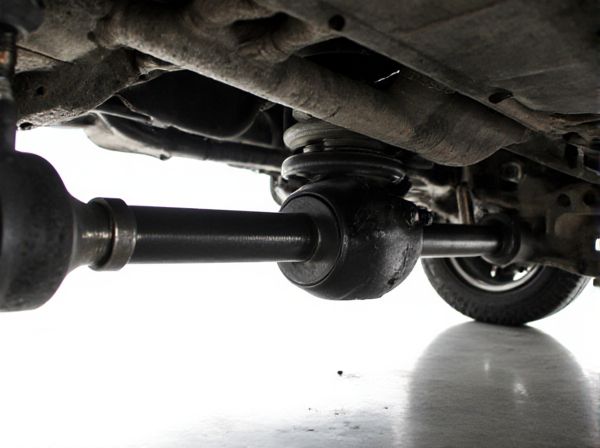
Photo illustration: Pushrod vs Pullrod Suspension
Pushrod suspension transfers forces through rods that push on the chassis, providing precise handling and improved aerodynamics in high-performance cars. Pullrod suspension, on the other hand, pulls on the chassis, lowering the center of gravity and allowing for more compact packaging, which can enhance vehicle stability and aerodynamics. Your choice depends on the desired balance between handling characteristics and design constraints in racing or performance vehicles.
Table of Comparison
| Feature | Pushrod Suspension | Pullrod Suspension |
|---|---|---|
| Design | Rod pushes on the rocker to compress spring | Rod pulls on the rocker to compress spring |
| Center of Gravity | Higher mounting position | Lower mounting position, reduces center of gravity |
| Aerodynamics | May interfere with airflow due to higher components | Improves airflow with lower profile setup |
| Complexity | More complex linkage and packaging | Simpler design, easier packaging in tight spaces |
| Usage | Common in Formula 1 and high-performance cars | Also used in F1, favored for chassis lowering |
| Maintenance | Generally easier to access components | More difficult due to lower placement |
Introduction to Suspension Systems
Suspension systems play a critical role in vehicle dynamics by managing wheel movement and maintaining tire contact with the road for optimal handling and ride comfort. Pushrod suspension utilizes a rod connected to the wheel hub that pushes on a rocker arm, transferring forces to inboard springs and dampers, offering aerodynamic advantages and reduced unsprung weight. Pullrod suspension, conversely, features a rod that pulls on the rocker arm, allowing lower mounting points for suspension components and contributing to a lower center of gravity, enhancing vehicle stability.
What is Pushrod Suspension?
Pushrod suspension uses rods connected from the wheel hub to a rocker or bell crank that transfers vertical wheel movement to horizontally mounted springs and dampers inside the chassis, allowing for reduced unsprung weight and improved aerodynamic efficiency. Commonly found in Formula 1 and high-performance race cars, pushrod setups provide precise handling and better suspension tuning due to their compact design and ability to lower the vehicle's center of gravity. This system enhances vehicle responsiveness and stability by optimizing load distribution and improving suspension geometry under dynamic driving conditions.
What is Pullrod Suspension?
Pullrod suspension is a vehicle suspension system where the suspension arms connect to the chassis through rods that pull rather than push, allowing for lower mounting of components and improved aerodynamics. It positions the springs and dampers inboard and lower, reducing the center of gravity and enhancing handling performance. Commonly used in high-performance and Formula 1 cars, pullrod suspension offers greater packaging efficiency compared to pushrod setups.
Core Differences Between Pushrod and Pullrod
Pushrod suspension features a pushrod arm that transfers forces upward to the rocker and damper, allowing better packaging efficiency and easier adjustment in high-performance vehicles. Pullrod suspension, in contrast, uses a pullrod arm that pulls downward on the rocker, lowering the vehicle's center of gravity and improving aerodynamic performance by enabling a lower chassis profile. The core difference lies in the force direction acting on the rocker--pushrod handles compression forces pushing upward, while pullrod manages tension forces pulling downward--impacting suspension layout, weight distribution, and vehicle dynamics.
Advantages of Pushrod Suspension
Pushrod suspension provides enhanced ride quality and handling by allowing precise control over wheel movement and suspension geometry. It reduces unsprung mass, which improves tire contact with the road for better grip and responsiveness. The design also offers superior packaging flexibility in high-performance vehicles, enabling optimized aerodynamics and weight distribution.
Advantages of Pullrod Suspension
Pullrod suspension offers advantages such as a lower center of gravity and improved aerodynamic efficiency due to its compact design and placement of components. It allows for better chassis rigidity and weight distribution, enhancing overall vehicle handling and responsiveness. The reduced unsprung mass also contributes to improved suspension performance and tire contact with the road.
Drawbacks of Pushrod Suspension
Pushrod suspension systems often suffer from increased complexity and higher manufacturing costs due to the intricate linkage design required to transfer loads from the wheel to the spring and damper assembly. The added components result in greater unsprung mass, negatively impacting vehicle handling and responsiveness. Furthermore, pushrod setups tend to limit packaging flexibility, making them less suitable for compact spaces compared to pullrod suspensions.
Drawbacks of Pullrod Suspension
Pullrod suspension systems often suffer from limited packaging efficiency due to the low mounting position of the rocker, which can restrict suspension travel and complicate maintenance. The design also tends to place higher stress on components, increasing the risk of fatigue and failure under extreme loads. Furthermore, pullrod setups can result in less precise suspension tuning compared to pushrod systems, potentially compromising handling and performance.
Pushrod vs Pullrod in Motorsport Applications
Pushrod suspension offers improved airflow and packaging flexibility in motorsport, allowing teams to optimize aerodynamics and lower the center of gravity. Pullrod suspension, often used in Formula 1 and endurance racing, provides a lower chassis profile and better weight distribution, enhancing handling and stability on high-speed circuits. Both systems influence suspension dynamics differently, with pushrods typically allowing easier setup adjustments and pullrods contributing to aerodynamic efficiency.
Choosing the Right Suspension: Key Considerations
Selecting the right suspension system involves evaluating factors such as vehicle weight distribution, desired handling characteristics, and aerodynamic goals. Pushrod suspensions offer easier adjustability and better packaging for front-end designs, whereas pullrod setups typically provide a lower center of gravity and improved airflow under the chassis. Engineers must balance these attributes with maintenance accessibility and track-specific performance requirements to optimize overall vehicle dynamics.
 caratoz.com
caratoz.com